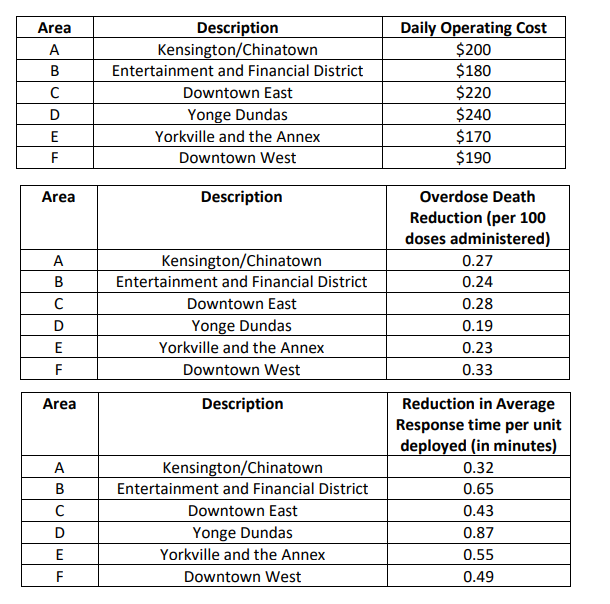(Solved): Rita Shahin is the public health officer for the Toronto District Region. She is attempting to deplo ...
Rita Shahin is the public health officer for the Toronto District Region. She is attempting to deploy mobile opioid overdose response units across different areas of downtown Toronto. The primary function of these mobile response units is to ensure that opioid users have a safe supply of needles and to minimize overdose deaths the that administration of naloxone (a drug that rapidly reverses the effects of an overdose). Secondary activities include providing supports and referrals for these clients for food, shelter and clothing. Dr. Shahin has 23 mobile response units that she would like to assign to the following six major areas within the Downtown Toronto;
Area A – Kensington Chinatown
Area B – Entertainment and Financial District
Area C – Downtown East
Area D – Yonge Dundas
Area E – Yorkville and the Annex
Area F – Downtown West
Each of these 6 major downtown areas require different operating costs per mobile unit deployed due to the varying conditions in each area. Dr. Shahin highest priority requirement is to maintain her daily operating costs to within $4,500 per day. The daily operating costs per downtown area are in the attached photo.
Dr. Shahin is interested in reducing the rates of overdose (per 100 injections). She believes that the presence of a mobile unit in a neighborhood will have the effect of reducing the rates of overdose deaths per 100 injections administered as follows. These rates vary by area, and are based on a per single mobile unit deployed into that area
Dr. Shahin’s second most important goal is to reduce the average overdose death rate for the entire district by at least 5 deaths (per 100 doses administered) If no mobile response units are assigned at all, the average time to respond to a distress call from an overdose anywhere in the district from the main headquarters is 28 minutes. For each mobile response unit that is deployed across any of the areas, the average reduction in response time will change as follows (note that response time improvements vary depending on the specific area):
Dr. Shahin’s third most important objective is to achieve an
average response time to overdose distress calls of 15 minutes. Due
to the political pressure coming from the various neighborhood
areas, Dr. Shahin is required to assign at least two mobile patrol
units to each area. In addition, Dr. Shahin believes that no area
should have deployed beyond a maximum of 5 mobile response units.
Formulate and solve a goal programming model to determine the
amount of mobile opioid overdose response units to assign to each
area to achieve her goals.
Expert Answer
Answer Canada's opioid emergency is complicated and multi-layered. The current excess emergency, driven essentially by a fast expansion in the utilization of fentanyl and other strong unlawful opioid drugs, has prompted an exceptional number of exces
